Hugh Dowding
Air Chief Marshal Hugh Caswall Tremenheere Dowding, 1st Baron Dowding, GCB, GCVO, CMG (24 April 1882 – 15 February 1970) was an officer in the Royal Air Force. He served as a fighter pilot and then as commanding officer of No. 16 Squadron during the First World War. During the inter-war years he became Air Officer Commanding Fighting Area, Air Defence of Great Britain and then joined the Air Council as Air Member for Supply and Research. He was Air Officer Commanding RAF Fighter Command during the Battle of Britain and is generally credited with playing a crucial role in Britain's defence, and hence, the defeat of Adolf Hitler's plan to invade Britain. He was replaced in command in November 1940 against his wishes with Big Wing advocate Sholto Douglas.
The Lord Dowding | |
|---|---|
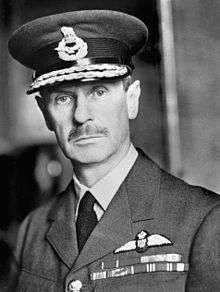 Lord Dowding | |
| Birth name | Hugh Caswall Tremenheere Dowding |
| Nickname(s) | Stuffy |
| Born | 24 April 1882 Moffat, Scotland |
| Died | 15 February 1970 (aged 87) Royal Tunbridge Wells, England |
| Allegiance | United Kingdom |
| Service/ | British Army (1900–18) Royal Air Force (1918–42) |
| Years of service | 1900–1942 |
| Rank | Air Chief Marshal |
| Commands held | RAF Fighter Command (1936–40) Air Member for Research and Development (1935–36) Air Member for Supply and Research (1930–35) Fighting Area, Air Defence of Great Britain (1929–30) RAF Transjordan and Palestine (1929) No. 1 Group (1920–22) No. 16 Group (1919–20) No. 16 Squadron (1915–16) |
| Battles/wars | First World War Second World War |
| Awards | Knight Grand Cross of the Order of the Bath Knight Grand Cross of the Royal Victorian Order Companion of the Order of St Michael and St George Mentioned in Despatches |
| Spouse(s) | Clarice Maud Vancourt
( m. 1918; died 1920)Muriel Whiting ( m. 1951) |
| Children | 1 |
Early life
Dowding was born at St. Ninian's Boys' Preparatory School in Moffat, Dumfriesshire, the son of Arthur John Caswall Dowding and Maud Caroline Dowding (née Tremenheere). His father had taught at Fettes College in Edinburgh before moving to the southern Scottish town of Moffat.[1] Dowding was educated at St Ninian's School and Winchester College.[2] He trained at the Royal Military Academy, Woolwich before being commissioned as a second lieutenant in the Royal Garrison Artillery on 18 August 1900.[3]
Military career
Promoted to lieutenant on 8 May 1902,[4] Dowding served with the Royal Garrison Artillery at Gibraltar, in Ceylon and in Hong Kong before being posted to No. 7 Mountain Artillery Battery in India in 1904.[5] After returning to the United Kingdom, he attended the Army Staff College 1912 before being promoted to captain on 18 August 1913 and being posted with the Royal Garrison Artillery on the Isle of Wight later that year.[5] After becoming interested in aviation, Dowding gained Aviator's Certificate no. 711 on 19 December 1913 in a Vickers biplane at the Vickers School of Flying, Brooklands.[6] He then attended the Central Flying School, where he was awarded his wings. Although added to the Reserve List of the Royal Flying Corps (RFC), Dowding returned to the Isle of Wight to resume his Royal Garrison Artillery duties. However, this arrangement was short lived and in August 1914, he joined the RFC as a pilot on No. 7 Squadron.[5]
First World War
Dowding transferred to No. 6 Squadron in October 1914 and then, after two weeks as a staff officer in France, became a Flight Commander, first with No. 9 Squadron and then with No. 6 Squadron. He became commanding officer of the Wireless Experimental Establishment at Brooklands in March 1915 and went on to be commanding officer of No. 16 Squadron in July 1915.[5] After the Battle of the Somme, Dowding clashed with General Hugh Trenchard, the commander of the RFC, over the need to give pilots some rest and recuperation. In September 1915 the author Duncan Grinnell-Milne joined No 16 squadron as a junior pilot. Years later he published an account of his time in the squadron, in which he criticises Dowding as being "too reserved and aloof from his juniors", although efficient.[7] Promoted to major on 30 December 1915, Dowding was recalled to England in January 1916, and, having been promoted to temporary lieutenant colonel on 1 February 1916 was given command of 7 Wing at Farnborough later that month. He transferred to the command of 9 wing at Fienvillers in June 1916. Returning to England, he was promoted to temporary colonel on 1 January 1917 on appointment as commander of the Southern Group Command and promoted to temporary brigadier-general on 23 June 1917 before being given command of the southern training brigade in August 1917. He was sent to York as chief staff officer to the RAF's senior administrative officer in the area in April 1918.[8] He was appointed a Companion of the Order of St Michael and St George on 1 January 1919.[5]
Inter-war years
Dowding was given a permanent commission in the RAF on 1 August 1919 with the rank of group captain.[9] He commanded No. 16 Group from October 1919 and then No. 1 Group from February 1920 where he was responsible for organising two of the annual air displays at Hendon. He was promoted to air commodore on 1 January 1922,[10] and served as chief staff officer at Inland Area headquarters at Uxbridge from February 1922 before being appointed Chief Staff Officer for RAF Iraq Command in August 1924.[5]
Dowding was an accomplished skier, winner of the first ever National Slalom Championship, and president of the Ski Club of Great Britain from 1924 to 1925.[11]
In May 1926 Dowding was appointed director of training at the Air Ministry. He was appointed a Companion of the Order of the Bath on 2 January 1928[12] and promoted to air vice-marshal on 1 January 1929.[13] Trenchard sent him to Palestine and Transjordan to study security problems caused by Arab–Jewish unrest: his reports, which gained Trenchard's approval, were a cause of further career advancement. Dowding became Air Officer Commanding Fighting Area, Air Defence of Great Britain in December 1929 and then joined the Air Council as Air Member for Supply and Research in September 1930. One of his first responsibilities in this post was the approval of the granting of a certificate of airworthiness to the R101 airship shortly before it set off on its ill-fated voyage to India; he later said "I think I was wrong not to insist on much more extensive trials and tests" and that his decision had been based on optimistic technical advice.[14] Dowding's time in this office coincided with a period of rapid development in aircraft design and a growing fear that another major war was on the horizon. Although without scientific or technical training, he displayed a great capacity for understanding technical matters. He was promoted to air marshal on 1 January 1933[15] and advanced to Knight Commander of the Order of the Bath on 3 June 1933.[16]
In July 1936 Dowding was appointed commanding officer of the newly created RAF Fighter Command, and was perhaps the one important person in Britain, and perhaps the world, who did not agree with British Prime Minister Stanley Baldwin's 1932 declaration that "The bomber will always get through".[17] He conceived and oversaw the development of the "Dowding system".[18] This consisted of an integrated air defence system which included (i) radar (whose potential Dowding was among the first to appreciate), (ii) human observers (including the Royal Observer Corps), who filled crucial gaps in what radar was capable of detecting at the time (the early radar systems, for example, did not provide good information on the altitude of incoming German aircraft), (iii) raid plotting, and (iv) radio control of aircraft. The whole network was linked in many cases by dedicated telephone cables buried sufficiently deeply to provide protection against bombing. The network had its centre at RAF Bentley Priory, a converted country house on the outskirts of London.[8] The system as a whole later became known as Ground-controlled interception (GCI).[19]
Dowding also introduced modern aircraft into service during the pre war period, including the eight gun Spitfire and Hurricane.[8] He is also credited with having fought the Air Ministry so that fighter planes were equipped with bullet proof wind shields.[20] He was promoted to air chief marshal on 1 January 1937[21] and appointed a Knight Grand Cross of the Royal Victorian Order on 23 January 1937.[22]
Second World War
Battle of Britain
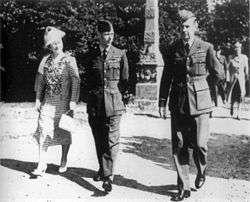
At the time of his retirement in June 1939, Dowding was asked to stay on until March 1940 because of the tense international situation. He was again permitted to continue through the Battle of Britain, first until July and finally until November 1940.[8] In 1940, Dowding, nicknamed "Stuffy" by his men for his alleged lack of humour,[23] proved unwilling to sacrifice aircraft and pilots in the attempt to aid Allied troops during the Battle of France. He, along with his immediate superior Sir Cyril Newall, then Chief of the Air Staff, resisted repeated requests from Winston Churchill to weaken the home defence by sending precious squadrons to France.[24] When the Allied resistance in France collapsed, he worked closely with Air Vice-Marshal Keith Park, the commander of 11 Fighter Group, in organising cover for the evacuation of the British Expeditionary Force at Dunkirk.[25]
Through the summer and autumn of 1940 in the Battle of Britain, Dowding's Fighter Command resisted the attacks of the Luftwaffe.[8] Beyond the critical importance of the overall system of integrated air defence which he had developed for Fighter Command, his major contribution was to marshal resources behind the scenes (including replacement aircraft and air crew) and to maintain a significant fighter reserve, while leaving his subordinate commanders' hands largely free to run the battle in detail.[8]
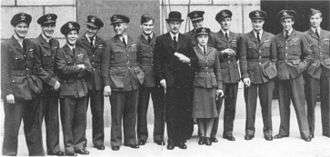
Dowding was known for his humility and great sincerity.[20] Fighter Command pilots came to characterise Dowding as one who cared for his men and had their best interests at heart. Dowding often referred to his "dear fighter boys" as his "chicks": indeed his son Derek was one of them.[8] Because of his brilliant detailed preparation of Britain's air defences for the German assault, and his prudent management of his resources during the battle, Dowding is today generally given the credit for Britain's victory in the Battle of Britain.[26]
Dowding's subsequent downfall has been attributed by some to his singlemindedness and perceived lack of diplomacy and political savoir faire in dealing with intra-RAF challenges and intrigues, most obviously the still, even now, hotly debated Big Wing controversy in which a number of senior and active service officers had argued in favour of large set-piece air battles with the Luftwaffe as an alternative to Dowding's successful Fabian strategy.[27] Another reason often cited for his removal, but characterised by some contemporary commentators more as a pretext, was the difficulty of countering German nighttime bombing raids on British cities.[28] The account of radar pioneer, E. G. Bowen in Radar Days (1987) rebuts the claim that Dowding's grasp of the problems of British night fighters was inadequate. He suggests that if Dowding had been left to follow his own path, the ultimately effective British response to night bombing (which depended completely on developments in air-borne radar) would have come somewhat sooner.[29] Dowding himself showed that he had a good grasp of night fighter defence and was planning a defence system against night bombing in a letter he wrote some time after the Battle of Britain. However, there was great political and public pressure during the Blitz for something to be done, and Fighter Command's existing resources without, as yet, airborne radar, proved woefully inadequate. A committee of enquiry chaired by Sir John Salmond produced a long list of recommendations to improve night air defence; when Dowding approved only some of them, his erstwhile supporters, Lord Beaverbrook and Churchill, decided that it was time for him to step down.[8]
Dowding was advanced to Knight Grand Cross of the Order of the Bath on 8 October 1940.[30] He unwillingly relinquished command on 24 November 1940 and was replaced by Big Wing advocate Sholto Douglas. Churchill tried to soften the blow by putting him in charge of the British Air Mission to the US, responsible for the procurement of new aircraft types.[31]
Publication of his book Twelve Legions of Angels was suppressed in November 1941.[32] The British Government considered that it contained information which might be of use to the Germans. The book was finally published in 1946, soon after the war ended.[8]
Ministry of Aircraft Production
After leaving Fighter Command, Dowding was sent on special duty to the United States for the Ministry of Aircraft Production, but there he made himself unpopular with his outspokenness. On his return he headed a study into economies of RAF manpower before retiring from the Royal Air Force in July 1942. He was elevated to the peerage, as Baron Dowding of Bentley Priory on 2 June 1943.[33]
Later life
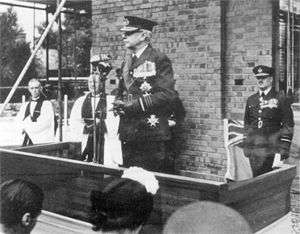
Later in life, because of his belief that he was unjustly treated by the RAF, Dowding became increasingly bitter. He approved Robert Wright's book Dowding and the Battle of Britain which argued that a conspiracy of Big Wing proponents, including Trafford Leigh-Mallory and Douglas Bader, had engineered his sacking from Fighter Command.[34] In the wake of the debate that followed, the RAF passed him over for promotion to Marshal of the Royal Air Force.[8]
In his retirement, Dowding became actively interested in spiritualism, both as a writer and speaker. His first book on the subject, Many Mansions, was written in 1943, followed by Lychgate (1945), The Dark Star and God's Magic. Rejecting conventional Christianity, he joined the Theosophical Society which advocated belief in reincarnation. He wrote of meeting dead "RAF boys" in his sleep – spirits who flew fighters from mountain-top runways made of light.[1]
In 1951, Dowding laid the foundation stone of the Chapel of St George at RAF Biggin Hill, now London Biggin Hill Airport, in memory of fallen airmen.[35]
Dowding and his second wife Baroness Dowding were both anti-vivisectionists and in 1973 Britain's National Anti-Vivisection Society founded the Lord Dowding Fund for Humane Research in his honour.[36]
Dowding became a vegetarian, based on his beliefs as a theosophist and spiritualist. Although he was a vegetarian, he believed that "animals will be killed to satisfy human needs for many a long day to come", and he made several appeals in the House of Lords for the humane killing of animals intended for food.[37] He was also a member of the Fairy Investigation Society.[38] Although he knew that people considered him a crank for his belief in fairies, Dowding believed that fairies "are essential to the growth of plants and the welfare of the vegetable kingdom".[39]
Death
Dowding died at his home in Royal Tunbridge Wells, Kent, on 15 February 1970. His body was cremated and its ashes were placed below the Battle of Britain Memorial Window in the Royal Air Force chapel in Westminster Abbey. Dowding's son Derek (1919–1992) inherited the title of Baron Dowding.[8]
Personal life
Dowding married Clarice Maud Vancourt, the daughter of an officer in the Indian Army, on 16 February 1918.[40] She had one child from a previous marriage, Marjorie Brenda Williams (1911–2003) and they had one child together, Derek Hugh Tremenheere (1919–1992).[41] Clarice died in 1920,[41] and Dowding's sister Hilda helped Dowding look after the two children.[41]
Dowding married Muriel Whiting (née Albino) on 25 September 1951; they had no children.[8][41]
Media portrayals
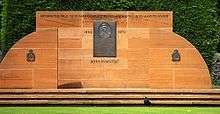
In the 1956 film Reach for the Sky, Dowding was played by Charles Carson.[42]
In the 1969 film Battle of Britain, Dowding was played by Laurence Olivier. Olivier had himself served as a pilot in the Royal Navy's Fleet Air Arm during World War II. During filming in summer 1968, 86 years old and wheel-chair-bound by severe arthritis, Dowding visited the set at Hawkinge airfield in Kent. Olivier told Dowding he had sat behind the latter's desk all day "pretending to be you" and was "making an awful mess of it too", to which Dowding replied, "Oh, I'm sure you are." This broke the crew and Olivier into laughter. Footage of this can be seen in the special features section of the film's Special Edition DVD.[43]
In the 2017 film Darkest Hour, Dowding was played by Adrian Rawlins.[44]
In the 2018 film Hurricane: 303 Squadron, Dowding was played by Nicholas Farrell.[45]
Honours and tributes
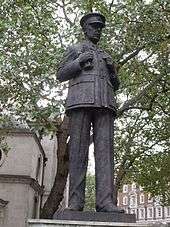
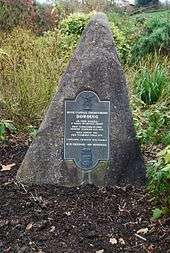
A statue of Dowding stands outside St Clement Danes church on the Strand, London. The inscription reads:
Air Chief Marshal Lord Dowding was commander-in-chief of Fighter Command, Royal Air Force, from its formation in 1936 until November 1940. He was thus responsible for the preparation for and the conduct of the Battle of Britain. With remarkable foresight, he ensured the equipment of his command with monoplane fighters, the Hurricane and the Spitfire. He was among the first to appreciate the vital importance of R.D.F. (radar) and an effective command and control system for his squadrons. They were ready when war came. In the preliminary stages of that war, he thoroughly trained his minimal forces and conserved them against strong political pressure to disperse and misuse them. His wise and prudent judgement and leadership helped to ensure victory against overwhelming odds and thus prevented the loss of the Battle of Britain and probably the whole war. To him, the people of Britain and of the Free World owe largely the way of life and the liberties they enjoy today.[46]
Other monuments to Dowding can be found in Station Park in Moffat, the town of his birth,[47] and in Calverley Gardens in Tunbridge Wells where he died.[48] The RAF Association in conjunction with the RAF Benevolent Fund, purchased his birthplace, the former St Ninian's School, Moffat;[49] the building was renamed Dowding House and restored to provide sheltered housing for former members of the Royal Air Force or their dependents.[50]
The Dowding Centre at the School of Aerospace Battle Management (formerly the School of Fighter Control) at RAF Boulmer is named after Dowding.[51]
A green ceramic commemorative plaque was unveiled at his former residence (1951–1967) in Darnley Drive, Southborough on 6 May 2012.[52]
Dowding Place, Stanmore, the site of former RAF Stanmore Park is named after him.
The 1946-built Southern Railway Battle of Britain pacific (4-6-2) locomotive 21C152 was named Lord Dowding in his honour.[53]
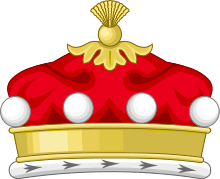  |
|
References
- "Battle of Britain and the fall of 'Stuffy' Dowding". The Herald. 8 September 2000. Retrieved 19 August 2014.
- Edkins, Richard. "Well Road and the Schools of Moffat". Moffat Business Index. Archived from the original on 17 September 2014. Retrieved 19 August 2014.
- "No. 27222". The London Gazette. 21 August 1900. p. 5174.
- "No. 27456". The London Gazette. 22 July 1902. p. 4671.
- "Air Chief Marshal Lord Dowding of Bentley Priory". Air of Authority – A History of RAF Organisation. Retrieved 19 August 2014.
- "Royal Aero Club of the United Kingdom: Official Notices to Members". Flight. 14 October 1914. Retrieved 19 August 2014.
- Grinnell-Milne 1933, pp. 42–3
- "Hugh Dowding". Oxford Dictionary of National Biography. Retrieved 19 August 2014.
- "No. 32372". The London Gazette. 28 June 1921. p. 5139.
- "No. 13774". The Edinburgh Gazette. 2 January 1922. p. 11.
- Carver 2005, p. 206
- "No. 14405". The Edinburgh Gazette. 3 January 1928. p. 5.
- "No. 33453". The London Gazette. 1 January 1929. p. 71.
- Wright 1970, p. 53
- "No. 33898". The London Gazette (Supplement). 30 December 1932. p. 16.
- "No. 14971". The Edinburgh Gazette. 6 June 1933. p. 468.
- Korda 2009, p. 18.
- Deighton 1980, pp. 88, 89.
- "Ground Controlled Interception Radars in Operation Neptune / Overlord" (PDF). Retrieved 19 August 2014.
- "Fighting The Blue". Yesterday TV. 25 June 2011. Retrieved 19 August 2014.
- "No. 34356". The London Gazette. 1 January 1937. p. 17.
- "No. 34420". The London Gazette. 23 July 1937. p. 4733.
- Waugh and Wright, p. 42
- Waligorski, Martin. "The Battle is Lost: Dowding's Letter Which Changed History". The Spitfire Site. Retrieved 19 August 2014.
- Braun, Simon. "The Command and Leadership Competence of Air Chief Marshal Sir Hugh Caswell Tremenheere Dowding GCB GCVO CMG ADC RAF". Royal Air Force. p. 4. Archived from the original on 3 March 2016. Retrieved 19 August 2014.
- Braun, Simon. "The Command and Leadership Competence of Air Chief Marshal Sir Hugh Caswell Tremenheere Dowding GCB GCVO CMG ADC RAF". Royal Air Force. p. 17. Archived from the original on 3 March 2016. Retrieved 19 August 2014.
- Korda 2009, pp. 124–125.
- Dixon 2009, pp. 103–120
- Bowen 1987, pp. 71, 119, 121.
- "No. 34964". The London Gazette. 8 October 1940. p. 5893.
- McKinstry 2010, pp. 222–3
- Slee, John (10 November 1941), "Banned", Daily Herald (United Kingdom)
- "No. 36087". The London Gazette. 9 July 1943. p. 3117.
- Wright 1970, p. 247
- "Say A Prayer for St George's Chapel" (PDF). RAF Chapel Biggin Hill. Retrieved 5 March 2016.
- "The Lord Dowding Fund for Humane Research". National Anti-Vivisection Society. Retrieved 19 August 2014.
- Orange 2008, p. 262.
- "Fairy Investigation Society". Strange History. Retrieved 19 August 2014.
- Orange 2008, p. 263.
- Orange, Vincent (2008). Dowding of Fighter Command: Victor of the Battle of Britain. Grubb Street. ISBN 978-1906502140.
- "Dowding-the Man Exhibition". Moffat Museum. Retrieved 26 June 2020.
- "Reach for the Sky". IMDB. Retrieved 8 May 2020.
- Battle of Britain film starring Harry Andrews, Michael Caine, Trevor Howard, et al. 1969
- "Darkest Hour". IMDB. Retrieved 8 July 2018.
- "Hurricane". IMDB. Retrieved 8 May 2020.
- "Lord Dowding". Open Plaques. Retrieved 19 August 2014.
- "Battle of Britain hero Hugh Dowding honoured in Moffat". BBC. 12 September 2010. Retrieved 19 August 2014.
- "Scottish granite memorial to Lord Dowding in Calverley Park, Tunbridge Wells, Kent". Retrieved 19 August 2014.
- "Dowding House". The Spectator. 21 November 1987. p. 35. Retrieved 26 January 2014.
- "RAFA Sheltered Housing". RAFA. Retrieved 19 January 2015.
- "Controllers Training Unit Calcutta". The Association of Royal Air Force Fighter Control Officers. Archived from the original on 14 July 2014. Retrieved 19 August 2014.
- "Sir Hugh Dowding plaque: Battle of Britain mastermind honoured". BBC. 6 May 2012. Retrieved 19 August 2014.
- "34052 – 'Lord Dowding'". Nine Elms. Retrieved 19 August 2014.
- Burke's Peerage. 1959.
Sources
- Bowen, E. G. (1987). Radar Days. Bristol, UK: Adam Hilger. ISBN 0-85274-590-7.
- Carver, Michael (2005). The Warlords. Pen & Sword. ISBN 978-1844153084.
- Deighton, Len (1980). Battle of Britain. London: Michael Joseph. ISBN 0-7181-3441-9.
- Dixon, J. E. G. (2009). Dowding and Churchill: The Dark Side of the Battle of Britain. Barnsley, South Yorkshire, UK: Pen & Sword Books. ISBN 978-1-84415-854-6.
- Grinnell-Milne, D. (1933). Wind in the Wires. London: Aviation Book Club. OCLC 7955618.
- Korda, Michael (2009). With Wings Like Eagles. New York: HarperCollins. ISBN 978-0-06-173603-2.
- McKinstry, Leo (2010). Hurricane: Victor of the Battle of Britain. John Murray (Publishers). ISBN 978-1-84854-339-3.
- Orange, Vincent (2008). Dowding of Fighter Command: Victor of the Battle of Britain. London: Grub Street. ISBN 978-1-906502-14-0.
- Waugh, S; Wright, J. (2010). War and the Transformation of British Society 1931–1951. London: Hodder Education. ISBN 978-0-340-98435-2.
- Wright, Robert (1970). Dowding and the Battle of Britain. Corgi Childrens. ISBN 978-0552085113.
Further reading
- Brown, Peter (2005). Honour Restored: The Battle of Britain, Dowding and the Fight for Freedom. Staplehurst, UK: Spellmount. ISBN 1-86227-301-4.
- Bungay, Stephen (2000). The Most Dangerous Enemy: A History of the Battle of Britain. London: Aurum Press. ISBN 978-1-84415-854-6.
- Collier, Basil (1957). Leader of the Few: the authorised biography of Air Chief Marshal Lord Dowding of Bentley Priory. Jarrolds. OCLC 123752575.
- Dixon, Jack (J E G) (2008). Dowding and Churchill: The Dark Side of the Battle of Britain. Pen & Sword, UK. ISBN 1-86227-301-4.
- Wright, Robert (1969). The man who won the Battle of Britain. Charles Scribner's Sons. OCLC 4169149.
External links
| Wikimedia Commons has media related to Hugh Dowding, 1st Baron Dowding. |
| Military offices | ||
|---|---|---|
| Preceded by Felton Holt |
Officer Commanding No. 16 Squadron 23 July 1915 – January 1916 |
Succeeded by D.W. Powell |
| Preceded by Vyell Vyvyan |
Air Officer Commanding Northern Area 1919 |
Succeeded by John Higgins |
| Preceded by Unknown |
Officer Commanding No. 16 Group 1919–1920 |
Vacant Group disbanded |
| Preceded by Unknown |
Officer Commanding No. 1 Group 1920–1922 |
Succeeded by Eugene Gerrard |
| Preceded by Thomas Higgins |
Director of Training 1926–1929 |
Succeeded by William Mitchell |
| Preceded by Patrick Playfair |
Air Officer Commanding RAF Transjordan and Palestine September–December 1929 |
Succeeded by Patrick Playfair |
| Preceded by Sir John Higgins |
Air Member for Supply and Research 1 September 1930 – 14 January 1935 |
Succeeded by Himself As Air Member for Research and Development |
| Succeeded by Cyril Newall As Air Member for Supply and Organisation | ||
| New title Created from part of the remit of the Air Member for Supply and Research |
Air Member for Research and Development 14 January 1935 – 1 April 1936 |
Succeeded by Wilfrid Freeman |
| New title Command established |
Commander-in-Chief Fighter Command 1936–1940 |
Succeeded by Sir Sholto Douglas |
| Peerage of the United Kingdom | ||
| New title Title created |
Baron Dowding 1943–1970 |
Succeeded by Derek Dowding |